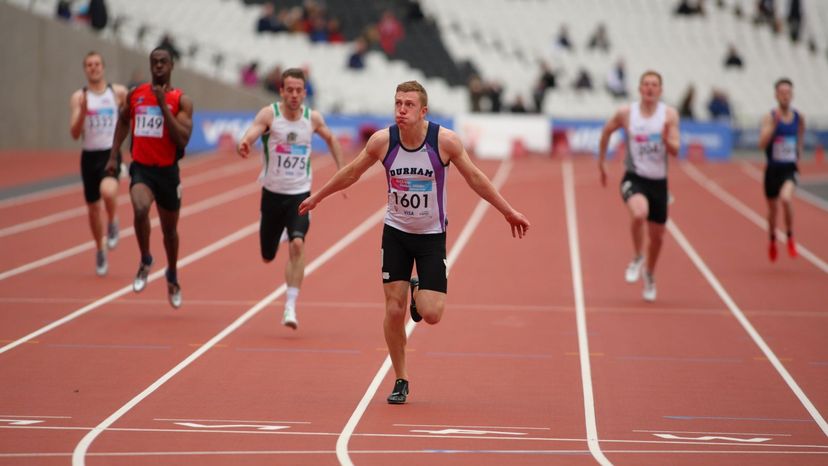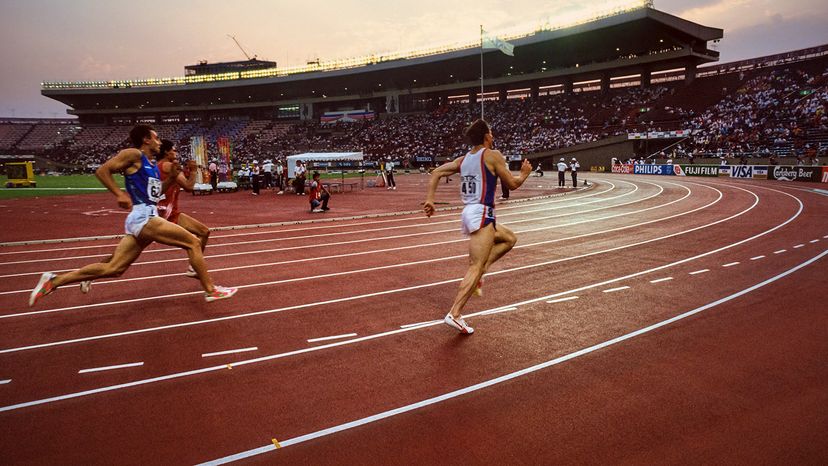In most races, the fastest runners are assigned to the middle lanes in accordance with the competition rules. Not surprisingly, the fastest runners — who are in the middle lanes — often win. Are these racers winning because those lanes are the fastest or because those runners tend to be the fastest?
Similar to the idea behind clinical trials for a drug, the ideal way to test lane advantages would be to randomly assign runners to lanes and see how they do on average. Thankfully, there is a subset of race data that does this: Typically, runners are randomly assigned to lanes in the first heats of events. By using data only from first heats of elite track and field events, I was able eliminate the bias from faster runners being assigned to certain lanes.
Using roughly 8,000 individual race results, I found that the "middle is best" belief is not well supported by the data.
For the 100 — which is run on a straightaway — I found no evidence of lane advantages. The myth is less prevalent here, though, so this lack of difference isn't surprising.
The most striking counterpoint to the "middle is best" assumption is the 200. I found that it is in fact outside lanes that are associated with faster race times — on average lane eight is roughly 0.2 seconds faster than lane two. This is sizable for a race in which the world record is 19.19 seconds. Faster outside lanes make sense biomechanically as tighter corners produce slower race times. But the result seems to disprove the idea that not seeing competitors can slow a runner down.
In the 400, I found no evidence that middle lanes are fastest. All lanes seem to be roughly equal. It is worth noting that there is more variability in 400-meter times, so it is harder to detect small effects, if they exist. But even this nondifference between lanes in the 400 is striking.
In the 2016 Olympics, people marveled when Wayde Van Niekerk won the 400 final from lane eight, the farthest outside lane. The astonishment stemmed from the belief that lane eight puts runners at a disadvantage. The data doesn't support this. But what is impressive about Van Niekerk's win is that he was one of the slower runners to qualify for the final — that's why he was assigned to one of the "least desirable" lanes.
The last event I looked at, the 800, is distinct from the other events above. It has what is called a "lane break," which is where runners must remain in their assigned lanes for the first 100 meters but are then free to run in any lane they wish. Since the inside lane of a track covers the shortest distance, runners in outside lanes move inward after the break. As they do this, they may have to run a tiny bit farther than their competitors and jockey for position with runners who are already in the inside lanes. I found that racers who start at the very inside lanes ran the fastest times. While outside lanes might have a small advantage over the first 100 meters, runners who have an established position on the inside of the track seem to have an overall advantage.
Next time you're watching any of the shorter track and field events at the Olympics, listen to see if anyone repeats the old adage that the middle lanes are fastest. The data says this isn't true, so if someone in the outside lanes takes a surprise gold, you'll know to be surprised not because of their lane assignment, but because they were a slow qualifier.
This article is republished from The Conversation under a Creative Commons license. You can find the original article here.
David R. Munro is an assistant professor of economics at Middlebury, where he joined the faculty in the fall of 2016, after completing his Ph.D. at the University of California, Santa Cruz. He holds a master's degree in economics from Chapman University and a bachelor's in engineering from the University of British Columbia.



